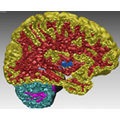Subject: CGAL users discussion list
List archive
- From: Olivier Devillers <>
- To:
- Subject: Re: [cgal-discuss] How to do 3D constrained Delaunay triangulation using CGAL
- Date: Fri, 30 Oct 2015 08:43:39 +0100
|
Le 29/10/15 18:30, 郑银河 a écrit :
That is exactly what I think yesterday. However, In order to use the meshing packages, I should construct the boundary mesh of the domain, which is pretty difficult because the boundary mesh may contain nonmainfold edges.I am not a specialist of mesh but the doc say that there is no need to be manifold 3D Mesh GenerationPierre Alliez, Clément Jamin, Laurent
Rineau, Stéphane Tayeb, Jane Tournois, Mariette Yvinec
This package is devoted to the
generation of isotropic simplicial meshes discretizing 3D
domains. The domain to be meshed is a region of 3D space that
has to be bounded. The region may be connected or composed of
multiple components and/or subdivided in several subdomains. The
domain is input as an oracle able to answer queries, of a few
different types, on the domain. Boundary and subdivision
surfaces are either smooth or piecewise smooth surfaces, formed
with planar or curved surface patches. Surfaces may exhibit
1-dimensional features (e.g. crease edges) and
0-dimensional features (e.g. singular points as corners tips,
cusps or darts), that have to be fairly approximated in the
mesh. Optionally, the algorithms support multi-core
shared-memory architectures to take advantage of available
parallelism.
... 1.1 Input DomainThe domain to be meshed is assumed to be bounded and representable as a pure 3D complex. A 3D complex is a set of faces with dimension 0, 1, 2 and 3 such that all faces are pairwise interior disjoint, and the boundary of each face of the complex is the union of faces of the complex. The 3D complex is pure, meaning that each face is included in a face of dimension 3, so that the complex is entirely described by the set of its 3D faces and their subfaces. However the 3D complex needs not be connected. The set of faces with dimension lower or equal than 2 forms a 2D subcomplex which needs not be manifold, neither pure, nor connected: some 3D faces may have dangling 2D or 1D faces in their boundary faces. |
- [cgal-discuss] How to do 3D constrained Delaunay triangulation using CGAL, 郑银河, 10/28/2015
- Re: [cgal-discuss] How to do 3D constrained Delaunay triangulation using CGAL, Sebastien Loriot (GeometryFactory), 10/28/2015
- Re: [cgal-discuss] How to do 3D constrained Delaunay triangulation using CGAL, Phil Weir, 10/28/2015
- Re: [cgal-discuss] How to do 3D constrained Delaunay triangulation using CGAL, 郑银河, 10/29/2015
- Re: [cgal-discuss] How to do 3D constrained Delaunay triangulation using CGAL, Olivier Devillers, 10/29/2015
- Re: [cgal-discuss] How to do 3D constrained Delaunay triangulation using CGAL, 郑银河, 10/29/2015
- Re: [cgal-discuss] How to do 3D constrained Delaunay triangulation using CGAL, Olivier Devillers, 10/29/2015
- Re: [cgal-discuss] How to do 3D constrained Delaunay triangulation using CGAL, 郑银河, 10/29/2015
- Re: [cgal-discuss] How to do 3D constrained Delaunay triangulation using CGAL, Olivier Devillers, 10/30/2015
- Re: [cgal-discuss] How to do 3D constrained Delaunay triangulation using CGAL, 郑银河, 10/29/2015
- Re: [cgal-discuss] How to do 3D constrained Delaunay triangulation using CGAL, Benjamin Kehlet, 10/29/2015
- Re: [cgal-discuss] How to do 3D constrained Delaunay triangulation using CGAL, Olivier Devillers, 10/29/2015
- Re: [cgal-discuss] How to do 3D constrained Delaunay triangulation using CGAL, 郑银河, 10/29/2015
- Re: [cgal-discuss] How to do 3D constrained Delaunay triangulation using CGAL, Olivier Devillers, 10/29/2015
- Re: [cgal-discuss] How to do 3D constrained Delaunay triangulation using CGAL, 郑银河, 10/29/2015
Archive powered by MHonArc 2.6.18.
